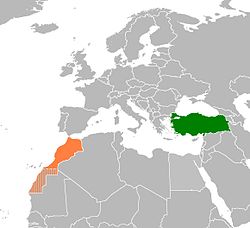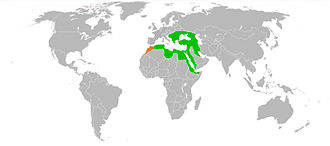- Morocco–Turkey relations
-
Turkey–Morocco relations 

Turkey
MoroccoTurkey–Morocco relations covers relations between Morocco and the Ottoman Empire, and spanned a period of several centuries, from the early 16th century to the 19th century when Northern Africa was taken over by France, until modern times.
Contents
First contacts (16th century)
From the early 16th century, the Ottomans had been constantly reinforcing their presence in northern Africa, starting as corsairs, from around 1500 to 1519.[1]
Ottoman occupation of Tlemcen (1517)
The Ottomans became very powerful with the Fall of Tlemcen (1517) and the Capture of Algiers (1516) and again the definitive Capture of Algiers (1529), progressively getting closer to the Moroccan zone of influence. After the 1517 fall of Tlemcen, the Sultan of Tlemcen had already fled to Fez in Morocco to find refuge.[2]
At the same time, the Spanish had been establishing numerous bases in Northern Africa, since 1496: Melilla (1496), Mers-el-Kebir (1505), Oran (1509), Bougie (1510), Tripoli (1510), then Algiers, Shershell, Dellys and Tenes.[3]
The Ottomans had been fighting as the enemies of Catholic Spain in North Africa. At the time the Saadian dynasty was emerging in southern Morocco, which had been successful in repelling the Portuguese from southern Morocco, particularly from Agadir in 1541. The Saadians desired to topple the Moroccan dynasty of the Wattasids in northern Morocco, and unify Morocco under one rule.[4]
Ottoman occupation of Tlemcen (1545)
The Moroccans and Ottomans started to interact closely from around 1545.[4] In June 1545, Hasan Pasha, son of Hayreddin Barbarossa and ruler of the Regency of Algiers, occupied the city of Tlemcen, where he set a Turkish garrison, and put pro-Ottoman Sultan Muhammad on the throne.[4] Tlemcen being a city with strong links with Fez, the Moroccan capital, Hasan Pasha hoped to establish an alliance with the Wattasids against the Spanish.[4] The Wattasids in turn hoped to obtain Ottoman military support against their enemies.[4]
The Saadians were the enemies of the Wattasids, but also considered the Ottomans with disdain: religiously, the Saadians were considered descendants of the Prophet, being Sherifians, whether the Ottomans were only recent converts in comparison.[4]
Wattasid alliance with the Ottomans
Things came to a head in 1545, when the Wattassid ruler of northern Morocco Sultan Ahmad was taken prisoner by his southern rivals the sharifian Sadiyans. His successor, Ali Abu Hassun, regent for Ahmad's young son Nasir al-Qasiri, decided to pledge allegiance to the Ottomans in order to obtain their support.[4] At the same time, the Ottoman started to exert direct influence in Tlemcen from 1545, where they ousted Mansur bin Ghani, the chief of the Banu Rashid, and placed Sultan Muhammad on the Tlemcen throne instead.[4]
Mansur bin Ghani went to Spain with Count Alcaudete, the Governor of Oran, to obtain military support for a campaign against the Ottomans. In 1547, Spain mounted an expedition against Ottoman Mostaganem, and failed, but in the meantime Mansur captured Tlemcen from the Ottomans and put his brother Ahmad in place as ruler. Following the Spanish defeat, the Ottomans reconquered the area, and again put Sultan Mohammad on the throne of Tlemcen.[4]
In Morocco, the Ottomans were unable to intervene when the Saadians conquered Fez in 1549, and ousted pro-Ottoman regent Ali Abu Hassun. Ali Abu Hassun was nevertheless offered asylum in Algiers.[4]
Direct conflict between the Saadians and the Ottomans
1551 Moroccan offensive
 Ornate Ottoman cannon founded in Algiers on 8 October 1581 by founder Ca'fer el-Mu'allim. Length: 385 cm, cal:178 mm, weight: 2910 kg, stone projectile. Seized by France during the invasion of Algiers in 1830. Musée de l'Armée, Paris.
Ornate Ottoman cannon founded in Algiers on 8 October 1581 by founder Ca'fer el-Mu'allim. Length: 385 cm, cal:178 mm, weight: 2910 kg, stone projectile. Seized by France during the invasion of Algiers in 1830. Musée de l'Armée, Paris.
As the Ottomans were set to put Ali Abu Hassun back on the throne, the Saadians set up an offensive on the Regency of Algiers in 1551.
The Saadian ruler Mohammed ash-Sheikh sent an army of 30,000 men, led by his son Muhammad al-Harran, to invade Tlemcen in 1551.[4] They took the city easily, from which the Ottoman garison had been removed in 1547. The Saadian army continued to the Ottoman stronghold of Mostaganem, but failed to capture the city.[4] On this occasion, the Emir of the Banu, which had been an enemy of the Ottomans for 30 years, actually sided with the Ottomans against the Saadians, and provided troops.[4] The Moroccan Saadian army was repulsed by the combinaison of tribal troops and Ottoman Janissaries led by Hasan Qusru.[4] Al-Harran died of illness in Tlemcen.[4] The last Zayyanid ruler of Tlemcen, Hasan, fled to Spain, and died there a few years later.[4]
Hasan Qusru managed to conquer Tlemcen from the Moroccans, and put an Ottoman governor and garrison in place, establishing direct Ottoman rule, and putting an end to the Zayyanid dynasty that had ruled the city.[4]
Ottoman capture of Fez (1554)
In 1552 Suleiman the Magnificent attempted a diplomatic rapprochement with the Saadians, putting the blame on Hasan Pasha for the conflict, and removing him from his rule in Algiers.[4] He was replaced by Salah Rais, who nevertheless marched on Fez and occupied the city in early 1554, when the Moroccan ruler Mohammed ash-Sheikh rejected cooperation with the Ottomans. He put Ali Abu-Hassun in place as Sultan of Fez, supported by Janissaries.[5] In September 1554 however, Mohammed ash-Sheikh managed to recapture Fez, and started negotiations with Spain to oust the Ottomans.[4]
Hasan Pasha was again named beylerbey of Algiers in June 1557, in order to continue the fight against the Moroccan ruler, who had formed an alliance with the Spanish against the Ottomans.[5] He had Mohammed ash-Sheikh assassinated in October 1557.[5]
Saadian-Spanish alliance
Ottoman invasion of Morocco (1558)
Hasan Pasha invaded Morocco in early 1558, but he was stopped by the Moroccan north of Fez at the Battle of Wadi al-Laban, and had to retreat upon hearing of Spanish preparations for an offensive from Oran.[5] He reembarked from the port of Qassasa in northern Morocco, and from there returned to Algiers to prepare a defense against the Spaniards.[5]
Mostaganem expedition (1558)
The Spanish attacked the Ottomans with Saadian support in the Expedition of Mostaganem (1558), but failed miserably.[5] The failure of the expedition of Mostaganem ended attempts at a grand alliance between Spain and Morocco against the common Ottoman enemy.[6]
Saadian primacy
Saadian dynastic feuds and Ottoman influence
 Ottoman Janissaries equipped with firearms (here at the Siege of Rhodes in 1522)
Ottoman Janissaries equipped with firearms (here at the Siege of Rhodes in 1522)
After the murder of Mohammed ash-Sheikh by the Ottomans in 1557 and the following struggle for power, the three younger sons of Mohammed ash-Sheikh had to flee their elder brother Abdallah al-Ghalib (1557–1574), leave Morocco and stay abroad until 1576. The three exiled brothers, Abdelmoumen, Abd al-Malik and Ahmad, the latter both future Sultans of Morocco, spent 17 years in exile Istanbul, where they received Ottoman training.[7] In January 1574, while in Istanbul, Abd al-Malik was saved from an epidemic by French physician Guillaume Bérard. They later became friends due to this event. When Abd al-Malik became Sultan, he asked Henry III of France that Guillaume Bérard be appointed Consul of France in Morocco.[8]
Abd al-Malik took service with the Ottomans. In 1574, Abd al-Malik participated to the Conquest of Tunis (1574) on the side of the Ottomans.[7] He was then able to invade Morocco with the help of a Ottoman Empire force of 10,000 soldiers dispatched from Algiers in 1576, and achieve the Capture of Fez.
Abd al-Malek recognized the Ottoman sultan Murad III as his Caliph, and reorganized his army on Ottoman lines and adopted Ottoman customs, but negotiated for the Ottoman troops to leave his country, in exchange for a large payment in gold.[9]
In the following period he tried to revive trade with Europe and especially England, starting an Anglo-Moroccan alliance with Elizabeth I. According to Richard Hakluyt, quoting Edmund Hogan, ruler "Abdelmelech" bears "a greater affection to our Nation than to others because of our religion, which forbids the worship of Idols".[10]
Battle of Ksar El Kebir (1578)
Main article: Battle of Ksar El KebirAfter losing the throne to Abd al-Malik, his predecessor Abu Abdallah Mohammed II (son of Abd al-Malik's eder brother Abdallah al-Ghalib), had been able to flee to Portugal and to convince King Sebastian to field a military campaign against Morocco. The campaign turned out to be a complete failure at the Battle of Ksar El Kebir in 1578. The combined forces of 25,000 Moroccans under Abd al-Malik and 15,000 Ottoman Janissaries prevailed. During the battle Abd al-Malik, already very ill, died. Upon his death, he was succeeded by his younger brother Ahmad al-Mansur (1578–1603).
Later relations
Although the Ottomans contributed to the final establishment of a stable Moroccan rule, Morocco was never nominally a part of the Ottoman Empire and remained independent thereafter. As the Ottoman Empire dominated Northern Africa, Morocco was the exception to that domination.[11]
Notes
- ^ Africa from the sixteenth to the eighteenth century by Bethwell A. Ogot p.238
- ^ "The town of Tenes fell into the hands of the brothers, with an immense booty, and then Uruj marched on Tlemcen. The Sultan of Tlemcen, the last of the royal race of the Beni-Zian, did not await the coming of the corsair." in Sea-Wolves of the Mediterranean by E. Hamilton Currey p.72ff
- ^ An Historical Geography of the Ottoman Empire p.107ff
- ^ a b c d e f g h i j k l m n o p q r s A history of the Maghrib in the Islamic period by Jamil M. Abun-Nasr p.155ff
- ^ a b c d e f A history of the Maghrib in the Islamic period by Jamil M. Abun-Nasr p.157ff
- ^ "the failure at Mostaganem, which brought the collapse of grandiose projects of alliance with Morocco" in Mediterranean and the Mediterranean World in the: Age of Philip II -2 by Fernand Braudel p.855
- ^ a b The last great Muslim empires: history of the Muslim world by Frank Ronald Charles Bagley, Hans Joachim Kissling p.103
- ^ Cervantes in Algiers: a captive's tale by María Antonia Garcés, p.277 note 39
- ^ The Cambridge History of Africa by J. D. Fage p.408- [1]
- ^ Shakespeare: The critical complex by Stephen Orgel p. 293 [2]
- ^ ["In the 1 6th century the North African countries, with the exception of Morocco, were absorbed into the Ottoman Empire." in The Encyclopedia of world history: ancient, medieval, and modern ... Peter N. Stearns p.366
 Foreign relations of Turkey
Foreign relations of TurkeyAfrica 
Americas Asia Europe - Abkhazia
- Albania
- Armenia
- Austria
- Azerbaijan
- Belgium
- Bulgaria
- Denmark
- European Union
- France
- Georgia
- Germany
- Greece
- Holy See
- Italy
- Kosovo
- Macedonia
- Malta
- Netherlands
- Poland
- Romania
- Russia
- Serbia
- Sweden
- Switzerland
- Spain
- Ukraine
- United Kingdom
Oceania Disputes Related topics - Ministry of Foreign Affairs
- Diplomatic missions of / in Turkey
- Turkish diplomats
- Turkish diaspora
 Foreign relations of Morocco
Foreign relations of MoroccoAfrica 
Americas Asia Europe Bulgaria · European Union · France · Greece · Netherlands · Norway · Portugal · Russia · Spain · Turkey · United KingdomWestern Sahara conflict Related topics Moroccan Ministry of Foreign Affairs Categories:- History of Morocco
- History of the Ottoman Empire
- Bilateral relations of Turkey
- Bilateral relations of Morocco
Wikimedia Foundation. 2010.



